καὶ πᾶν ὅ τι ἐὰν ποιῆτε ἐν λόγῳ ἢ ἐν ἔργῳ, πάντα ἐν ὀνόματι Κυρίου Ἰησοῦ . . . ὃ ἐὰν ποιῆτε, ἐκ ψυχῆς ἐργάζεσθε ὡς τῷ Κυρίῳ καὶ οὐκ ἀνθρώποις.
Proclaim the name of the Lord in everything you do . . . and work with all your heart for the Lord and not for men.
Colossians 3: 17, 23
κήρυξον τὸν λόγον, ἐπίστηθι εὐκαίρως ἀκαίρως.
Be ready to preach the word at the proper time and also at the improper time.
2 Timothy 4:2
ἣν ὡς ἄγκυραν ἔχομεν τῆς ψυχῆς ἀσφαλῆ τε καὶ βεβαίαν.
[In Christ] we have an anchor for the soul, both secure and unshakable.
Hebrews 6:19
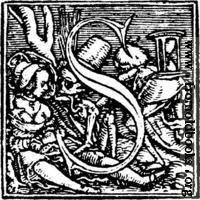 O, HERE I AM patiently photographing all of my silver coins and entering them into the coll. (the bronzes come next), when I come across this anomaly, this weirdness, this coin that isn't doing what it's supposed to do, RIC 54 var. I flip it over to photograph the reverse and all of a sudden it's upside down. What the hell.
O, HERE I AM patiently photographing all of my silver coins and entering them into the coll. (the bronzes come next), when I come across this anomaly, this weirdness, this coin that isn't doing what it's supposed to do, RIC 54 var. I flip it over to photograph the reverse and all of a sudden it's upside down. What the hell.
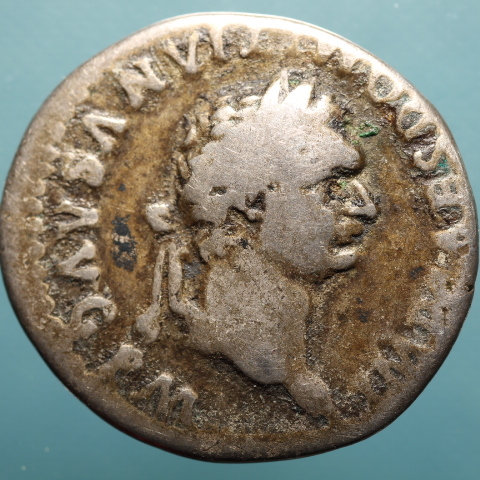

Roman coins just aren't supposed to behave this way. The mint in Rome struck their coins so that when you flip them over top to bottom the reverse is upright, just like with American coins today. This is called a "six-o'clock" orientation. In the Greek east it was the opposite, you need to flip the coins over side to side to get the same result, a "twelve-o'clock" orientation. Every Domitianic coin minted in Rome is 6h. There aren't any exceptions.
Except, so it happens, for this one reverse type, and only uniquely (it would seem at this point) rarely. The British Museum coll. has two 12h denarii of Domitian, BMC 21 and BMC 29, both of them dolphin/anchor reverses like this one, but two different issues and varieties, 81, second issue, RIC 55 (var) and 82, first issue, RIC 96 (var). Let me emphasize that these coins are exceptional, only three in my experience (since Thursday when I discovered mine, the day before yesterday as I write this)*. Most (almost all) dolphin/anchor-reverse denarii have conventional 6h orientation. Here is RIC 2 from my own collection--
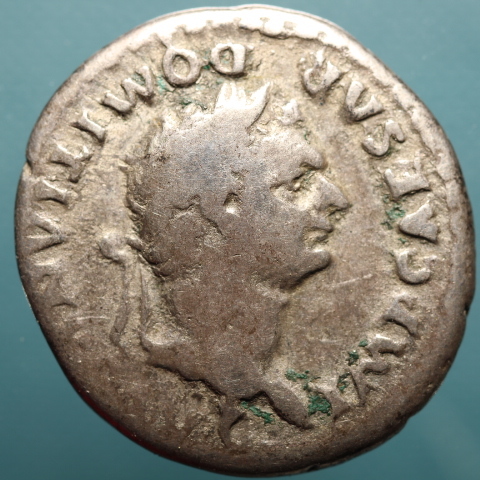
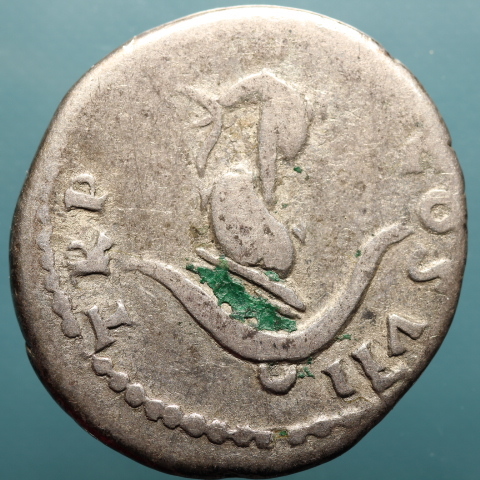
See? No surprise, conventional orientation. But, to continue my story, I just sat there for a few minutes staring at the damn thing, turning it over, scratching my head, etc.--I hadn't yet checked it out in the BMC catalog. What had happened to cause this? Was it an error? Was it deliberate? I was pondering all of this when I was struck by a new thought. The upside-down anchor with the dolphin's body entwined around it reminded me a little bit of Christ contortionate on the cross. Indulge me for a moment and compare it to the El Greco painting below.
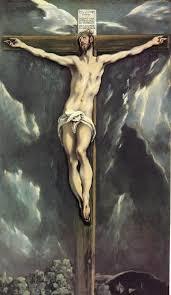
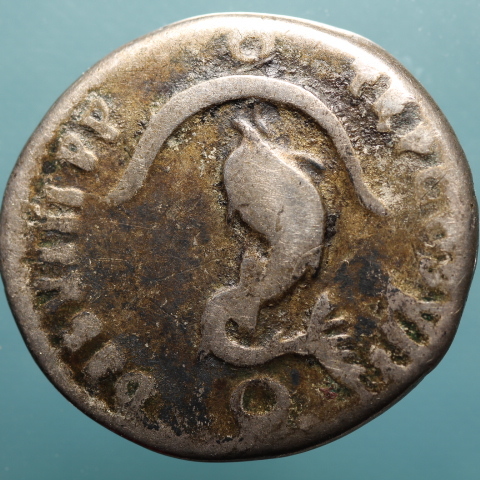
The design structure is similar, the strong central vertical, the similar S-shapes, the iconography of a living body attached to an inanimate object. Interesting, I thought, and I wondered for a moment if a first-century Christian might have seen the same thing. But no, he wouldn't have. It probably wouldn't have occurred to him, uninformed by the Renaissance, never mind two millennia of Christian art. The image of Christ on the cross was not a Christian symbol in the art of the 1st C. This fact may surprise today's Christians but it's true.
Last time I was in Rome I visited the Catacombs of St Priscilla. This excursion wasn't on my itinerary but it was raining and the entrance to the catacombs happened to be near where I was staying. This was in 2015, before I started collecting coins again and before I had developed my peculiar interest in Domitian. When I return at the end of this November (before moving on in December to my beloved Venice), I plan to visit all of the catacombs, Domitian's house on the Palatine and his villa at Alba, now the Villa Barberini, the papal Castel Gandolfo, all with new eyes! But at the time, back in 2015, sadly much of the catacomb experience was lost on me.
I was certainly impressed by much of the art though. As an artist myself this was natural. Here is a tomb-image carved in sandstone from the Catacombs of Priscilla--
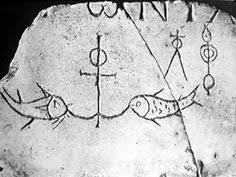
These two early Christian symbols, the anchor and the fish, joined together like this is the iconic image of these catacombs. This terracotta tile, which now serves as a trivet for hot dishes in my dining room, is a souvenir from the gift shop--
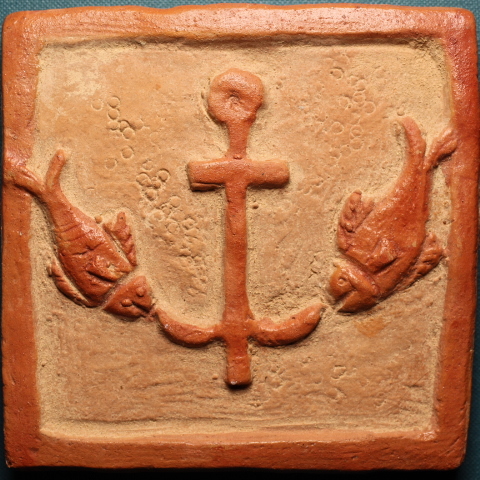
The anchor represents hope, the firm hope of the resurrection embodied in Christ, as cited in the reference above (Hebrews 6:19). The fish is a little more interesting. It represents an acronym or more properly an acrostic. The Greek word for fish is ΙΧΘΥΣ, ichthus, an acrostic for Ἰησοῦς Χριστός, Θεοῦ Υἱός, Σωτήρ, Jesus Christ, Son of God, Savior. Pretty cool. Now, the dolphin, to the Romans (Christian and pagan alike), was a fish, the king of fish but a fish, a friendly, intelligent, even helpful sort of fish but a fish nevertheless. So when a 1st-C. Christian saw an anchor/dolphin symbol he didn't see what a 1st-C. pagan saw, the attributes of the god Neptune, he saw Jesus Christ.
Returning to the mint now and the question, what's the deal with the 12h orientation on these three denarii? Was it a mint error or was it deliberate? It's only my opinion, but I would call it deliberate. One time is odd, twice is a coincidence, but three times is a pattern, a pattern of deliberate action. So now the question is why? Why would anyone do this?
A Christian might have done it. I can't imagine why anybody else would, but a Christian might have done it, proclaiming the Lord in everything he did, turning the process of creating graven images for the pagans into a subversive act of quiet Christian rebellion, rendering unto God a thing that was Caesar's. To what purpose? Maybe to no purpose at all other than turning the face of the Christ/fish heavenward, but maybe not even that. Perhaps he turned the die around to set it apart and make it different from the dies he didn't turn around. To make this particular image special in some way. Maybe this Christian at the mint just wanted people to know that there was a Christian at the mint. Yes, I believe that's what happened here, and this coin is the evidence of it, a first-century equivalent of Kilroy was here.
* Alberto Tricarico reports that in his quite extensive collection which includes six different varieties with this reverse, five denarii and one aureus, four of the denarii have the 12h orientation. So seven now in my experience! Thanks, Alberto. Armed with this information and confident of a deliberate pattern of behavior at the mint, I will be changing the names of RIC 2 and RIC 54 var in this collection to RIC 2(a) and RIC 54(b) to reflect this now recognized varietal difference, and subsequent examples will be identified accordingly.
Soon: SALVTI AVGVSTI: Concerning Domitian's poor health on his return from Germany

